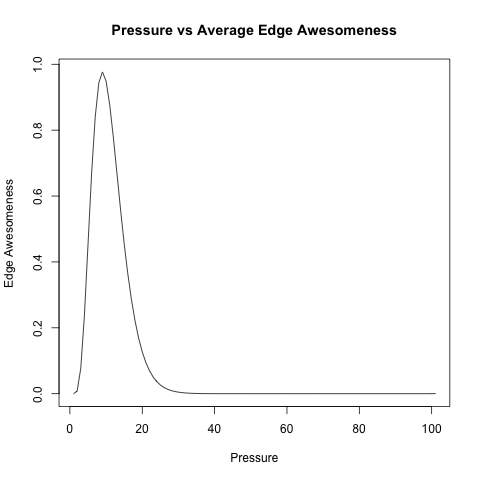Results 1 to 10 of 24
Thread: Less pressure = razor sharp
Threaded View
-
12-26-2013, 03:13 AM #5There is no charge for Awesomeness



- Join Date
- Aug 2006
- Location
- Maleny, Australia
- Posts
- 7,977
- Blog Entries
- 3
Thanked: 1587
Yes, I did a funded study (ASRRC, grant no. SR0002) on this a little while ago. The main result can be shown in the following graph:

The y axis represents edge awesomeness (a term coined by the author at the behest of the editors which unfortunately hides a rather complex and brilliantly clever iteratively reweighted monte carlo based edge shaveability measure discussed in an upcoming short article published in Nature). The X axis shows pressure, as measured using a modified Sturmey-Archer gaussian random field Newtrometer.
The graph is the result of 200,000 individual hone-shave repetitions for each treatment combination in a fractional factorial design. Treatment combinations consisted of steel type (3 types), grind type (5 grinds), razor size (8 sizes), hone progression (15 progressions, comprising the 15 most common bevel-to-finisher stone combinations as data mined from the user databases of SRP, B&B, TSD, Coticule.be (to be honest, only one combo from that site...), and R&S.
Shave tests were conducted on hemispherical ballistics gel moulds impregnated with beard hair, randomly selected from over 15,000 barber shops worldwide.
The results are clearly conclusive. Due to the nature of the edge awesomeness measure, an edge awesomeness of > 0.85 yields an acceptable shave, on average. From the graph we see that too little pressure is ineffective. Too much pressure is ineffective. Pressure in the range of approximately 10-15 Jimbopascals clearly yields the best and most awesome edges, on average (p<0.0001). This clearly ties in with previous studies by Jimbo et al (ASRRC grant no. SR0001) and confirms the so-called "goldilocks" effect postulated in that seminal work.
James.<This signature intentionally left blank>
-


 73Likes
73Likes LinkBack URL
LinkBack URL About LinkBacks
About LinkBacks






 Reply With Quote
Reply With Quote